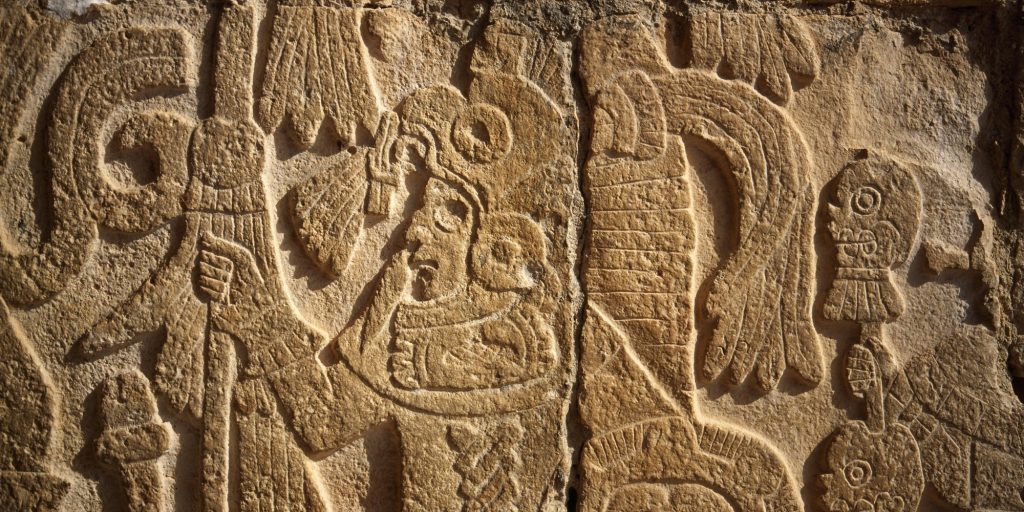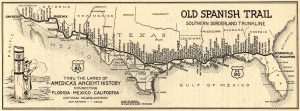The decline of the Classic Maya civilization is one of the greatest mysteries in human history. As described by archaeologist Arthur Demarest, “probably only the fall of the Roman Empire has been cited as often in social theory on the decline of civilizations.”1 But, what were the reasons why one of the most important Mesoamerican civilizations collapsed? What led the Maya to their fall? Although the reasons for the collapse are still debated, scholars have tried to answer these questions for decades. Most of the theories that scholars have developed as an explanation for the reasons for the decline include environmental degradation due to agriculture; overpopulation; disease; political decline; invasions; a revolution of peasants; and the newest theory adopted by scientists, climate change. All these theories come from the long-time work and study of archaeologists that have been interested in one of the greatest mysterious declines in history. All of their hypotheses present many strong and plausible arguments; yet, some of these theories also manifest certain flaws that have led to further questioning. Again, all of these theories can be said to be plausible. The collapse of the Classic Maya could, in fact, be caused by a combination of several factors that, combined, were greater than the abilities of the Mayan people to overcome.

Maya history is divided into three major periods: Preclassic (2000 B.C.E.-200 C.E.); Classic (200 C.E.-900 C.E.); and Postclassic (900 C.E. to the Spanish conquest). The Maya inhabited the present-day southern Mexican states of Chiapas, Campeche, Tabasco, Yucatán, and Quintana Roo; as well as the countries of Belize, Guatemala, Honduras, and El Salvador.2 Scholars divide the areas where the Maya lived into three regions: “the southern subregion of Guatemala highlands and the Pacific coast; the central subregion of northern Guatemala, its adjacent lowlands, and the Petén region; and the northern subregion of the Yucatán Peninsula.”3 It was during the Classic period that the rise of larger and more advanced city-states occurred.4 It was also during this period that the collapse of the civilization began.

The decline of the Maya manifested gradually. One by one, the activities from various city-states started to decline. Archaeologist J. Eric S. Thompson presented his theory on the collapse of the Maya in 1954. His main argument is that the city-states collapsed due to a revolt of the peasants, who may have removed the original authorities and taken the power themselves.5 Yet, these people did not know how to manage the economy and maintain an empire standing. According to his theory, the revolt of the peasants may have been caused by the “ever growing demands for service and in construction work and in the production of food for an increasing number of nonproducers.”6 Thompson also mentions several theories that have been presented by other scholars. For example, he mentions how it was believed that the Maya people from the Central area had migrated to the northern area of Yucatán and to the highland of Guatemala, helping the development of the Maya culture in these areas; yet, more recent research has shown that in both regions, the Maya flourished throughout the entire Classis period.7 Another theory addressed and rejected by Thompson is that the death rate of girls was higher than that of boys in villages near Lake Petén. The explanation for this is that girls had less economic importance. This eventually may have led to the depopulation of some cities. However, considering the fact that fewer women inhabited these cities, the price for brides would drastically increase and by consequence, parents would take more care of their girls.8 In addition, Thompson rejected the theory that diseases like malaria or yellow fever may have contributed to the decline, since these diseases are known to be introduced by the Spanish conquerors.9

A similar theory to that of Thompson, focusing also on the political issues of the Maya city-states, was introduced by archaeologist Arthur Demarest in 2005. Demarest claims that the decline of the Classic Maya civilization was affected by the collapse of a political system established in the lowlands.10 According to his research, a flexible royal system was established in the lowlands that allowed the succession of the ruler by a son (not automatically the eldest son), a brother, or any other male relative; and in some instances, a queen would take the throne after the ruler’s death. This flexible system was also very unstable; it fostered frequent battles for the throne. In consequence, “the instability of the system was aggravated by the redundant, segmentary nature of the political order.”11 Another factor that could have influenced the political decline of the lowland cities was the ineffective management of the economy. Most Maya states were “decentralized with local community or family-level management of most aspects of economy.”12 The stresses in the economy of these Maya states may have left many of the cities unsteady and internally disintegrated compared to other Mesoamerican civilizations.13
Demarest’s idea that the political weakness of city-states leaving these cities vulnerable to other rising civilizations can be related to the work of archaeologists Michael D. Coe and Stephen Houston. Their work analyzes different theories previously presented by Maya archaeologists such as “endemic internecine warfare, overpopulation (and accompanying environmental collapse), and drought.”14 In their analysis, warfare and invasion may have been earlier problems than any of the other two presented ideas. Archaeologist Akira Taneko may have found strong evidence for the role of war among the Maya city-states and how the war influenced the collapse of the Maya.15 Taneko found 217 projectile points in one of the buildings in the city of Yaxchilan; almost all projectiles “had been used on darts propelled by atlatls—mute testimony to a final battle sealing the city’s death.”16 Regarding the other two theories, overpopulation and environmental collapse, and drought, Coe and Houston analyze the claim that the population of the Maya cities in the lowlands began to increase by the end of the eighth century C.E. The necessity for providing people with food consequently increased the level of agriculture in these areas. Based on their research, “there is mounting evidence for massive deforestation and erosion throughout the Central Area and Copan.”17 Similarly, archaeologists’ work describes a series of droughts that may have influenced the decline of the civilization. Accordingly, there was a severe drought lasting from 820 C.E. to 860 C.E., followed by a couple of brief, yet intense droughts between 860 C.E. and 1000 C.E. and possibly lasting until 1100 C.E. Combining all social, political, and ecological stresses that the Maya were experiencing, these droughts may have brought the end of the Classic civilization.18

The idea of drought has been present for several years. The hypothesis of megadroughts affecting the Maya communities was related to climate change by archaeologist Richardson Gill. He argues that when temperatures in the Northern hemisphere increased, there was “increased rainfall in the Maya lowlands. When cooler conditions prevail, conditions are drier and the onset of the rainy season is delayed.”19 Gill recognizes a series of megadroughts that may have affected the Maya zones, calling them “Preclassic Abandonment (c. A.D. 150-200), Hiatus (A.D. 530-590), the classic collapse of the eighth and ninth centuries, and the Postclassic Abandonment (around A.D. 1450).”20 Gill’s theory is supported by a study by Frank Chambers and Michael Ogle that shows that between 800 C.E. and 1000 C.E. the region experienced “the driest [period] of the middle-late Holocene epoch, and coincided with the collapse of classic Maya civilization.”21 However, archaeologist David Webster’s argument against this theory is that the decline of the Maya was mostly experienced in the humid south instead of the northern areas of the peninsula that were dyer.22
From the evidence presented by these various scholars, one can conclude that the Maya experienced rough times during a period that was once its major point of flourishing. Among all theories presented, the one that may have had the larger impact would be the several droughts. The control of a factor such as climate change was not in the hands of the Maya people. Yet, another theory that may be well sustained is that the ineffectiveness of the political system may have significantly influenced the collapse of the city-states. Without the right people in power to execute the rules for maintaining control, it may have been more difficult to distribute and make good use of the resources available for the Maya.
There is a possibility that we may never know the entire story for the Maya collapse. It is worth mentioning that the research into the end of this civilization only refers to the Classic Maya. Today, there are still several Maya peoples still living in some of the areas they formerly occupied since the beginning of their history: Mexico, Guatemala, Belize, Honduras, and El Salvador. Scholars will continue looking for explanations that bring them closer to an answer that many still seek: what exactly led to the end of one of the greatest Mesoamerican civilizations?
- Arthur Demarest, Ancient Maya: The Rise and Fall of a Rainforest Civilization (New York: Cambridge University Press, 2005), 240. ↵
- Salem Press Encyclopedia, January 2016, s.v. “Maya Civilization,” by Philip E. Lampe. ↵
- Salem Press Encyclopedia, January 2016, s.v. “Maya Civilization,” by Philip E. Lampe. ↵
- Salem Press Encyclopedia, January 2016, s.v. “Maya Civilization,” by Philip E. Lampe. ↵
- J. Eric S. Thompson, The Rise and Fall of Maya Civilization (University of Oklahoma Press, 1954), 105. ↵
- Thompson, The Rise and Fall of Maya Civilization, 105. ↵
- Thompson, The Rise and Fall of Maya Civilization, 102. ↵
- Thompson, The Rise and Fall of Maya Civilization, 104. ↵
- Thompson, The Rise and Fall of Maya Civilization, 104. ↵
- Demarest, Ancient Maya, 242. ↵
- Demarest, Ancient Maya, 244. ↵
- Demarest, Ancient Maya, 246. ↵
- Demarest, Ancient Maya, 246. ↵
- Michael D. Coe and Stephen D.Houston, The Maya, Ninth edition (New York: Thames & Hudson, 2015), 175. ↵
- Coe and Houston, The Maya, 175. ↵
- Coe and Houston, The Maya, 175. ↵
- Coe and Houston, The Maya, 176. ↵
- Coe and Houston, The Maya, 176-177. ↵
- David Webster, The Fall of the Ancient Maya: Solving the Mystery of the Maya Collapse, 1st edition (London: Thames & Hudson, 2002), 241. ↵
- Webster, The Fall of the Ancient Maya, 241. ↵
- Frank Chambers and Michael Ogle, Climate Change: Natural Climate Change: Proxy-Climate Data (Taylor & Francis, 2002), 264. ↵
- Webster, The Fall of the Ancient Maya, 244. ↵



96 comments
Natalie Childs
This was a really well done article. I really enjoyed reading about what the author saw as possible reasons, and the sources that he used for support or rejection of theories presented. The Mayan’s were an absolutely incredible civilization, as well as incredibly advanced. With every suggestion from drought to peasant revolt due to lack of public administration, it really is a shame that a civilization as great as the Mayans doesn’t have a more definitive known reason for its fall.
Andrew Dominguez
It surprises me that we know so much of the Maya civilization, yet we still don’t know why they disappeared. I liked the author addressed multiple theories on why they might have fallen. The super flood seemed like it wouldn’t happen since it would have to have been a large flood. Which the people could have been able to flee to another location to settle.
Fumei P.
I thought that their civilization was wiped out by diseases and that they were conquered by the Spanish. Maybe there was a combination of things that led to its collapse, probably everything the writer mentioned to include poor government at that time. The Super flood is an interesting theory as well, that never even crossed my mind, but I suppose a natural disaster would explain such a large decline even before the Spanish were in the picture.
Natalia Flores
That was a very nice touch to say that the Maya peoples still live on since i have been to the Yucatan peninsula and visited Tulum and on that trip I meet several people from Maya communities. The fall of the Maya empire is something very dynamic and different since entire city-states were abandoned. The over population theory doesn’t really stick for me since there were trade routes from the Mayas, to the Aztecs, and up to North America. So if the Maya peoples wanted, they could have spread all across Mexico and the US. Drought, however, seems more plausible since both Mayan and Aztec civilizations relied heavily on climate and have several gods dedicated to that.
Hector Garcia
The Maya was one of the greatest Mesoamerican civilization and it surprises me that we still don’t know what led to their collapse. I really liked when the writer was able to discuss multiple theories that might have led to the Mayans demise. And right now, I am interested in what really happened during the epoch. Could it have been because there was a severe drought or a foreign invasion that wipe out most of the Mayan civilization?
Austin Pena
Great article! It was interesting to read of the possible factors that played a role in the fall of a great civilization. It was interesting to read that political and environmental factors could have played a part in the fall of the civilization. I would have though it to be diseases that caused then to fall but now I see that they may have been going downhill before the Spanish conquest
Tyler Thompson
I was always unaware of the unexpected downfall of the Mayan’s. This was a very well structured article that described historical events. It is still unsure of what happened to the society. There are many theories, and one that seems most logical is the running out of natural resources.
Nathan Hudson
When it comes to the downfall of civilizations that were flourishing hundreds of years ago, many theories of what actually happened are to be expected. I was shocked to read about the theories of politics that lead to the demise of the Mayans. Disease and famine were only the logical explanation in my head, but after reading this very descriptive article, it makes sense that revolutions and such could have caused poor management. I bet those peasants were upset after they killed their only means of survival.
Angela Rodriguez
Very interesting, organized and well written article. Prior to reading this article, I was aware of their sudden decline but I did not know there still was not a definite answer as to why the Maya Civilization collapsed. I enjoyed reading about the different theories presented by these scholars and I myself believe that the droughts had a big factor in the decline. No one is going to want to settle somewhere where they know they are not going to the have the basic essentials (ie. food, water) to survive.
Lisa Varela
This was a very informative news article. It had a lot of facts and theories about the fall of the Mayan empire. The end to the Mayan civilization may always be a mystery because we may never know exactly what happened but the theories presented were well presented and explained. When I visited places in Mexico I have read a little about the theories, but I never knew that there were so many.